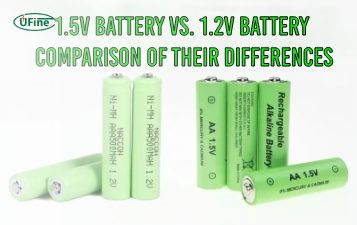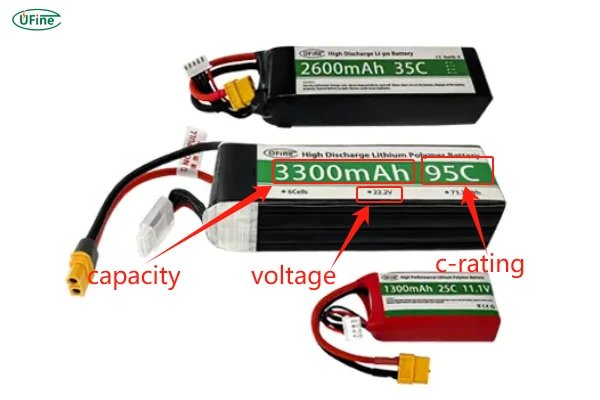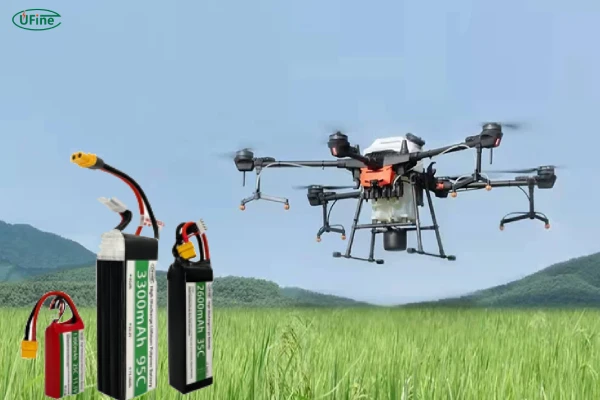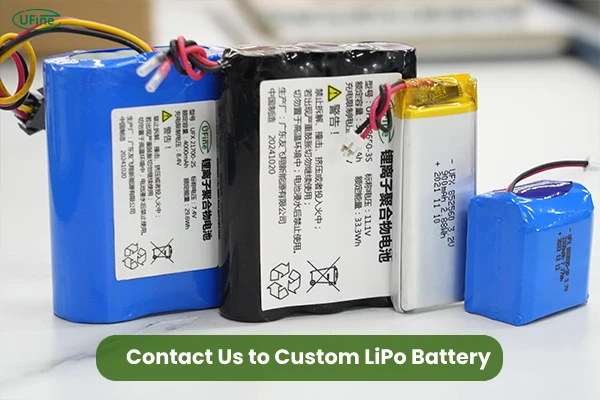
- Part 1. Learn 22.2 v lipo battery
- Part 2. What devices use 22.2V LiPo batteries?
- Part 3. Capacity matters
- Part 4. Discharge rate and performance (C-Rating)
- Part 5. 22.2V LiPo battery vs. 14.8V and 11.1V batteries
- Part 6. Charging a 22.2V LiPo battery
- Part 7. How to store and handle 22.2V LiPo batteries
- Part 8. Common issues and how to solve them
Part 1. Learn 22.2 v lipo battery
Understanding battery voltage is the first step to appreciating the power behind a 22.2V LiPo battery. Voltage determines the energy output of a battery, and for 22.2V, it means that this battery contains six cells arranged in a series. Each cell has a nominal voltage of 3.7V, adding up to 22.2V (3.7V x 6). When fully charged, the voltage increases to 25.2V (4.2V x 6), providing an initial burst of power that is vital for high-demand devices like drones or high-performance RC cars.
But it’s important to note that voltage alone doesn’t determine how effective a battery will be. The actual capacity (measured in mAh or Ah) and discharge rate (measured in C-rating) will also have a significant impact on how the battery performs in your device.
Part 2. What devices use 22.2V LiPo batteries?
One of the first things to understand about the 22.2V LiPo battery is that it’s designed for high-demand applications. It’s not just a “run-of-the-mill” battery—it’s made for those who need performance. You’ll find these batteries powering a wide variety of devices, including:
- Drones: Particularly in racing drones and high-end aerial photography drones, where long flight times and quick bursts of power are essential.
- RC Cars and Trucks: For the enthusiast who wants top-tier speed and handling, the 22.2V LiPo delivers.
- Electric Skateboards and Scooters: These high-voltage batteries can give a significant boost to electric rideable vehicles, offering a longer range and faster acceleration.
- Industrial Applications: In robotics and some high-powered tools, a 22.2V LiPo battery can deliver the energy needed for optimal performance.
Understanding how these batteries impact performance is key. When paired with the right motor and electronics, a 22.2V LiPo battery unlocks the full potential of your device, providing both speed and endurance.
At Ufine Battery, we offer customized 22.2V LiPo solutions, ensuring that you get the right battery for your specific needs, whether it’s for consumer-grade electronics or industrial machinery.
Part 3. Capacity matters
When selecting a 22.2V LiPo battery, you need to look beyond voltage and think about capacity. The capacity, measured in milliamp hours (mAh), indicates how much charge a battery can hold and, by extension, how long it will power your device before needing a recharge.
Common capacities for 22.2V LiPo batteries include:
- 2200mAh: A light option for applications that need power but not for extended periods (e.g., smaller drones).
- 5000mAh: This is a balanced option, offering a good trade-off between runtime and weight, suitable for medium-sized drones or RC cars.
- 10000mAh: Larger capacities for those who need more power for extended usage times—ideal for heavy-duty drones or vehicles.
However, while higher capacities can extend runtime, they also add more weight. This can affect the maneuverability of the device. So, choosing the right capacity is all about balancing power, weight, and performance needs. Ufine Battery can help you customize 22.2V LiPo batteries with specific capacities that match your unique requirements.
Part 4. Discharge rate and performance (C-Rating)
The C-rating of a battery indicates how quickly it can discharge its stored energy without damaging itself. For example, a 50C discharge rate means the battery can safely release 50 times its capacity per hour. If you have a 5000mAh 22.2V battery with a 50C rating, it can safely discharge at 250 amps.
Why does this matter? In high-performance devices like RC cars or racing drones, a high C-rating ensures the battery can deliver rapid bursts of energy, like during acceleration or when changing direction quickly. If the C-rating is too low, the battery could overheat, degrade faster, or even fail.
Understanding C Rating on LiPo Battery: Your In-Depth Guide
To make sure your device gets the right performance, always match the C-rating of your battery to the needs of your motor and electronic systems. Choosing a high-performance battery that can handle intense loads without risk of failure is essential for safety and optimal performance. If you need a customized solution, Ufine Battery offers a wide range of LiPo batteries with different C-ratings, designed to suit various levels of performance and usage.
Part 5. 22.2V LiPo battery vs. 14.8V and 11.1V batteries
It’s helpful to understand how the 22.2V LiPo battery compares to other popular options like the 14.8V and 11.1V LiPo batteries. The key difference is in the voltage and, consequently, the amount of power they deliver.
- 11.1V LiPo (3S): Ideal for beginners and lighter applications. Offers less power but is simpler and safer to use.
- 14.8V LiPo (4S): Provides a nice balance between power and safety. Suitable for medium-performance devices.
- 22.2V LiPo (6S): This is where you get the real power. Designed for advanced users who need high speed, torque, and long flight times.
While 22.2V LiPo batteries are fantastic for high-power devices, they also come with more complexity. It’s essential to match the battery to your device’s voltage requirements. Using a 22.2V battery in a device that’s designed for 14.8V can lead to malfunction or even damage.
Part 6. Charging a 22.2V LiPo battery
Charging your 22.2V LiPo battery correctly is just as important as choosing the right one. To safely charge a 22.2V LiPo, you’ll need a 6S LiPo charger—a charger specifically designed to handle six cells. This ensures each cell charges evenly, which helps prevent dangerous imbalances that can lead to overheating or fire.
Charging tips:
- Always use a balance charger designed for 6S batteries.
- Charge in a LiPo-safe bag or fireproof container to reduce the risk of fires.
- Never leave a charging battery unattended.
Part 7. How to store and handle 22.2V LiPo batteries
The 22.2V LiPo battery is powerful, but it can also be dangerous if not stored and handled properly. Always store your battery in a cool, dry place. LiPo batteries are sensitive to temperature, and extreme heat or cold can shorten their lifespan or cause them to fail.
Key safety practices include:
- Storing at storage voltage (3.8V per cell) for long-term storage.
- Never store your battery in a fully charged or fully discharged state.
- Avoid puncturing, crushing, or short-circuiting the battery.
- Always use a fireproof storage bag.
Part 8. Common issues and how to solve them
Like any technology, 22.2V LiPo batteries can run into issues over time. Some of the most common problems include:
- Swelling: This can happen due to overcharging, over-discharging, or age. Swollen batteries should be disposed of properly.
- Unbalanced cells: A sign that the cells aren’t charging or discharging equally. Use a balance charger to resolve this.
- Voltage drop: A sign that the battery may be worn out or that the C-rating is too low for your setup.
Related Tags:
More Articles

1.5V Battery Vs. 1.2V Battery: Comparison of Their Differences
Compare 1.2V vs 1.5V batteries: voltage, usage, rechargeability. Best for remotes, toys, cameras. Discover which AA battery suits your device.
Recommended 10 Best Batteries For Smoke Detectors
Discover the best batteries for smoke detectors in 2025. Compare top 10 9V and AA options for long-lasting, leak-proof, and reliable smoke alarm power.
Triple A Battery Voltage: Everything You Need to Know
Learn how many volts are in a triple A battery (1.5V vs 1.2V), see AAA battery voltage chart, and compare chemistry, testing, and lifespan for 2025 devices.
9V vs AA Batteries for Fire Alarm: Which One Should You Use?
Compare 9V and AA batteries for smoke detectors. Learn which type provides better lifespan, voltage, and cost efficiency to keep your fire alarms reliable.
Flashlight Battery Size: Types, Choosing Tips and FAQs
Explore flashlight battery sizes with an easy chart. Learn what batteries small flashlights use and how to pick 18650, 26650, 14500, or CR123A cells.





